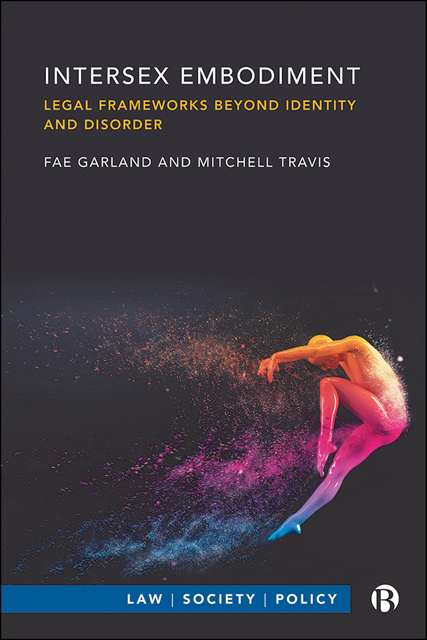Book contents
- Frontmatter
- Dedication
- Contents
- Series Editor’s Preface
- List of Abbreviations
- Acknowledgements
- 1 Introduction: Embodying Intersex
- 2 Medical Embodiment: Intersex as Disorder
- 3 Non-Binary Embodiment: Intersex and Third-Gender Markers
- 4 LGBT Embodiment: Queerness, Homonormativity and Anti-Discrimination Law
- 5 Engaging with Intersex Experience: Can Law Disrupt Medical Embodiment?
- 6 Intersex as Acceptance and Emergence: Can Psychosocial Frameworks Disrupt Medical Embodiment?
- 7 Conclusion: Intersex Embodiment
- References
- Index
4 - LGBT Embodiment: Queerness, Homonormativity and Anti-Discrimination Law
Published online by Cambridge University Press: 17 June 2023
- Frontmatter
- Dedication
- Contents
- Series Editor’s Preface
- List of Abbreviations
- Acknowledgements
- 1 Introduction: Embodying Intersex
- 2 Medical Embodiment: Intersex as Disorder
- 3 Non-Binary Embodiment: Intersex and Third-Gender Markers
- 4 LGBT Embodiment: Queerness, Homonormativity and Anti-Discrimination Law
- 5 Engaging with Intersex Experience: Can Law Disrupt Medical Embodiment?
- 6 Intersex as Acceptance and Emergence: Can Psychosocial Frameworks Disrupt Medical Embodiment?
- 7 Conclusion: Intersex Embodiment
- References
- Index
Summary
Introduction
In Chapter 3, we set out the problematic ways in which states frame intersex embodiment through a non-binary lens. This form of recognition misrecognizes many intersex people, constructing intersex in a way that is often unsuited to their lived experience. As we found from our interviews, many intersex people identify strongly within the gender binary and do not feel comfortable with the idea that intersex is synonymous with non-binary. As a result, third markers are an ineffective mechanism through which to disrupt medical embodiment and potentially harmful state response when used as a solitary or mandatory way of recognizing intersex persons. Our respondents felt that was particularly the case for children as this was more likely to encourage parents to undergo non-therapeutic medical interventions in order to avoid their child being determined as outside of the gender binary (Carpenter, 2018).
This chapter introduces a third way in which intersex embodiment is constructed – where intersex bodies are constructed as ‘LGBT’. This LGBT framing applies regardless of the sexual or gender identification of the intersex person. Consequently, while intersex people might not necessarily agree with this framing on an individual level, through discursive and institutional positioning intersex people are understood through a lens of LGBT (Garland and Travis, 2020c). This framing of intersex embodiment as LGBT is constructed through (and produces much of) the stigma that intersex people face. As noted in Chapter 2, this stigma has roots within homophobia but, more recently, also shares similarities with transphobia. The stigmatization of LGBT embodiment plays out in a number of different ways for intersex people in the way in which they manage and experience their bodies and identities. Firstly, it contributes to the medical management and framing of intersex embodiment. As we identified in Chapter 2 much of the rationale for medical interventions on intersex people stemmed from an institutional desire to police same-sex relations relationships (Foucault, 1980; Dreger, 1998; Holmes, 2008a; Malatino, 2019). Early calls to medicalize the determination of sex were done explicitly to prevent ‘unnatural’ relations (Loir, 1854: 1). Loir suggested that same-sex relationships could be prevented, at least in part, by policing intersex people through the registration of indeterminate sex on birth certificates, medicalizing sex registration and the physical examination of intersex people before marriage (Loir, 1854; Mak, 2005).
- Type
- Chapter
- Information
- Intersex EmbodimentLegal Frameworks beyond Identity and Disorder, pp. 78 - 108Publisher: Bristol University PressPrint publication year: 2022



